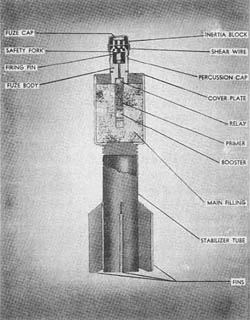 This grenade, designed to be fired from Models 38 and 99 rifles by means of a spigot launcher and wooden bullet, is similar in use and operation to the Model 91 rifle grenade. However, it is smaller and has a smooth-wall body rather than the serrated type. It contains a cyclonite primer enclosed in a brass container, a tetryl booster, and a three-ounce bursting charge of cast TNT; it is also fitted with an instantaneous fuze and a tail assembly with four fins spot welded to the rear part of the tube.
This grenade, designed to be fired from Models 38 and 99 rifles by means of a spigot launcher and wooden bullet, is similar in use and operation to the Model 91 rifle grenade. However, it is smaller and has a smooth-wall body rather than the serrated type. It contains a cyclonite primer enclosed in a brass container, a tetryl booster, and a three-ounce bursting charge of cast TNT; it is also fitted with an instantaneous fuze and a tail assembly with four fins spot welded to the rear part of the tube.
The grenade is armed by the removal of a safety fork. On impact, an inertia block is forced into the fuze body shearing a brass shear wire and driving the firing pin into the detonator.
SPECIFICATIONS
| Diameter of grenade body | 1.63 ins. | |
| Length of grenade body | 2.43 ins. | |
| Wall thickness | 1/8 in. | |
| Overall length of grenade | 7.88 ins. | |
| Weight of grenade without explosive | 14 ozs. | |
| Weight of explosive body without explosive | 10 ozs. | |
| Length of fin assembly | 4 15/16 ins. | |
| Outside diameter of tube | 1 13/16 ins. | |
| Inside diameter of tube | 1 1/16 ins. | |
| Width of tail assembly | 2 1/8 ins. | |
| Length of tail fin | 2 3/8 ins. | |
| Width of tail fin | 1/4 in. | |
| Material of construction | Steel | |
| Weight of main charge | 3 ozs. | |
| Weight of primer | 3 gr. | |
| Weight of booster | 1 gr. |
Japanese: p. 304.2 (April 1, 1945)
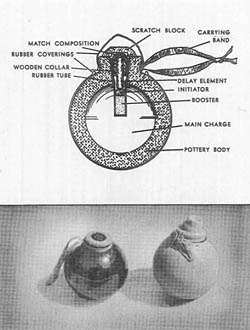 This hand grenade, made of terra cotta, and, like the Model 3 Flower Pot Land Mine, filled with Type 88 explosive, is assumed to be a Navy weapon. Except for the neck at the top, it is spherical, consisting of two halves baked together. It is light brown, in color, and lightly glazed both inside and out. The grenade is encased in a straw-colored, waterproof rubber sack.
This hand grenade, made of terra cotta, and, like the Model 3 Flower Pot Land Mine, filled with Type 88 explosive, is assumed to be a Navy weapon. Except for the neck at the top, it is spherical, consisting of two halves baked together. It is light brown, in color, and lightly glazed both inside and out. The grenade is encased in a straw-colored, waterproof rubber sack.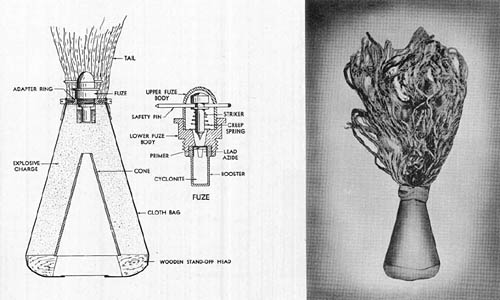
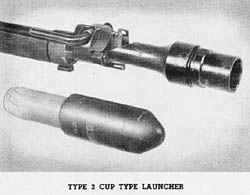 The Type 2, which is patterned after the German grenade launcher of the same type, fits over the front sight of the rifle and has a short rifled barrel. It fires both the
The Type 2, which is patterned after the German grenade launcher of the same type, fits over the front sight of the rifle and has a short rifled barrel. It fires both the 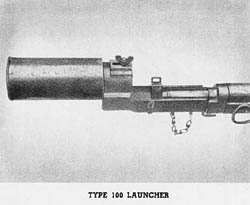 The Type 100 may be used with either the
The Type 100 may be used with either the 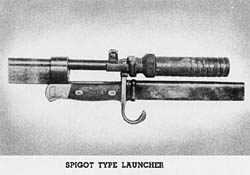 The spigot type launcher, which may be used with either the Type 38 or Type 99 rifle, fires the Type 91, Type 3 H.E., and several types of smoke and incendiary grenades. It consists of a rifled barrel threaded to an adapter. The launcher is attached to the rifle at the rear of the front sight mount by two locking arms on the adapter. When a bayonet is fixed to the rifle, additional stability is obtained by the use of a two-pronged lug on the adapter which fits on the bayonet guard.
The spigot type launcher, which may be used with either the Type 38 or Type 99 rifle, fires the Type 91, Type 3 H.E., and several types of smoke and incendiary grenades. It consists of a rifled barrel threaded to an adapter. The launcher is attached to the rifle at the rear of the front sight mount by two locking arms on the adapter. When a bayonet is fixed to the rifle, additional stability is obtained by the use of a two-pronged lug on the adapter which fits on the bayonet guard.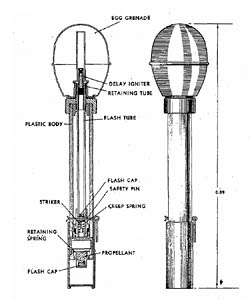 This pistol grenade is formed by adding to the egg-type hand grenade (Eierhandgranate 39) a plastic stem to which it is attached by a retaining tube. The tube contains the delay igniter at the forward end inside the grenade. An alloy flash tube connects this to the fuze which is located in the base of the stem. The fuze is separated from the primer by a safety pin which is pulled out before the grenade is placed in the pistol barrel. Upon firing, the firing pin strikes the primer which sets off the delay igniter, detonating the explosive charge after a delay of 4.5 seconds.
This pistol grenade is formed by adding to the egg-type hand grenade (Eierhandgranate 39) a plastic stem to which it is attached by a retaining tube. The tube contains the delay igniter at the forward end inside the grenade. An alloy flash tube connects this to the fuze which is located in the base of the stem. The fuze is separated from the primer by a safety pin which is pulled out before the grenade is placed in the pistol barrel. Upon firing, the firing pin strikes the primer which sets off the delay igniter, detonating the explosive charge after a delay of 4.5 seconds.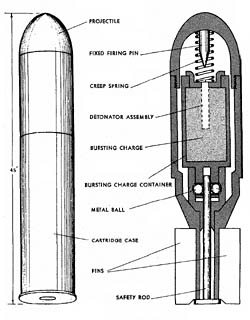 This grenade, consisting of a rounded nose cap screwed to a cylindrical body, is equipped with four fins which are fixed to the base of the body. A brass or aluminum cartridge crimped to the grenade completes the assembly. A case containing the detonator and main filling is separated from a fixed firing pin in the nose of the grenade by a creep spring. The case is prevented from moving forward before firing by two metal balls in the base of the carrier. An arming rod inserted between the two balls prevents them from moving. This is forced out of the base by setback about ten or twelve yards after the grenade leaves the muzzle of the gun. The balls then slide out of their grooves and the case is free to move against the firing pin, exploding the grenade on impact.
This grenade, consisting of a rounded nose cap screwed to a cylindrical body, is equipped with four fins which are fixed to the base of the body. A brass or aluminum cartridge crimped to the grenade completes the assembly. A case containing the detonator and main filling is separated from a fixed firing pin in the nose of the grenade by a creep spring. The case is prevented from moving forward before firing by two metal balls in the base of the carrier. An arming rod inserted between the two balls prevents them from moving. This is forced out of the base by setback about ten or twelve yards after the grenade leaves the muzzle of the gun. The balls then slide out of their grooves and the case is free to move against the firing pin, exploding the grenade on impact.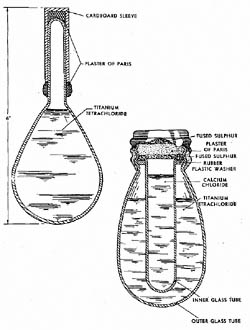 These grenades are made in the form of glass flasks. Model 1H is a single container; Model 2H includes an inner glass tube filled with a solution of calcium chloride. The body of each grenade is filled with titanium tetrachloride which vaporizes, upon contact with the air. The calcium chloride permits the second model to operate at low relative humidity, whereas the first model produces a thin fog unless the air is quite moist. Both models discharge upon impact with any hard object.
These grenades are made in the form of glass flasks. Model 1H is a single container; Model 2H includes an inner glass tube filled with a solution of calcium chloride. The body of each grenade is filled with titanium tetrachloride which vaporizes, upon contact with the air. The calcium chloride permits the second model to operate at low relative humidity, whereas the first model produces a thin fog unless the air is quite moist. Both models discharge upon impact with any hard object.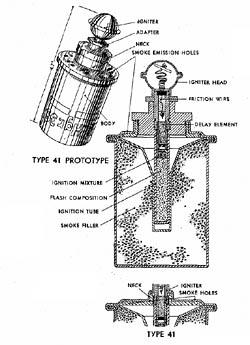 The prototype of this grenade is comprised of the body of the smoke hand grenade 39 with a synthetic resin adapter to hold the B. Z. E. igniter. The Model 41 is of similar construction but the body has been modified so that the igniter fits into a small central neck without the use of an adapter. There are only two smoke holes instead of eight. The friction igniter operates with a 4-5 second delay, setting off a 2-minute smoke discharge.
The prototype of this grenade is comprised of the body of the smoke hand grenade 39 with a synthetic resin adapter to hold the B. Z. E. igniter. The Model 41 is of similar construction but the body has been modified so that the igniter fits into a small central neck without the use of an adapter. There are only two smoke holes instead of eight. The friction igniter operates with a 4-5 second delay, setting off a 2-minute smoke discharge.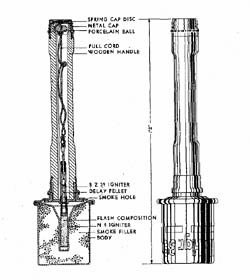 This grenade closely resembles the high explosive stick grenade 24 in external form and size. However, instead of the high explosive filling this grenade is filled with a smoke mixture. There are eight holes in the base of the head through which the smoke escapes. The handle has three horizontal corrugations at the screw cap end to assist in differentiation by touch. Upon activation, smoke is emitted for a period of two minutes, forming an effective screen for machine gun nests and pillboxes.
This grenade closely resembles the high explosive stick grenade 24 in external form and size. However, instead of the high explosive filling this grenade is filled with a smoke mixture. There are eight holes in the base of the head through which the smoke escapes. The handle has three horizontal corrugations at the screw cap end to assist in differentiation by touch. Upon activation, smoke is emitted for a period of two minutes, forming an effective screen for machine gun nests and pillboxes.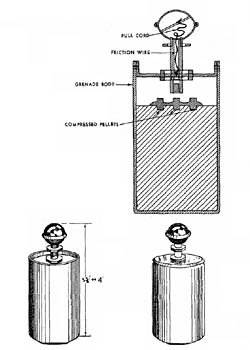 This is a thin-cased offensive type grenade with a B. Z. E. friction igniter screwed into the top. The cylindrical body is made of aluminum and painted yellow. There are two models of this grenade, one 3 5/8 inches long and the other 4 inches long. This grenade may also be used as a booby trap by the insertion of a D. Z. 35 Pressure Igniter. To operate the grenade, the head of the igniter is unscrewed and pulled, drawing the wire through the friction composition and igniting the delay pellet. The grenade is then thrown and after a 4-5 second delay, the delay element initiates the detonator.
This is a thin-cased offensive type grenade with a B. Z. E. friction igniter screwed into the top. The cylindrical body is made of aluminum and painted yellow. There are two models of this grenade, one 3 5/8 inches long and the other 4 inches long. This grenade may also be used as a booby trap by the insertion of a D. Z. 35 Pressure Igniter. To operate the grenade, the head of the igniter is unscrewed and pulled, drawing the wire through the friction composition and igniting the delay pellet. The grenade is then thrown and after a 4-5 second delay, the delay element initiates the detonator.